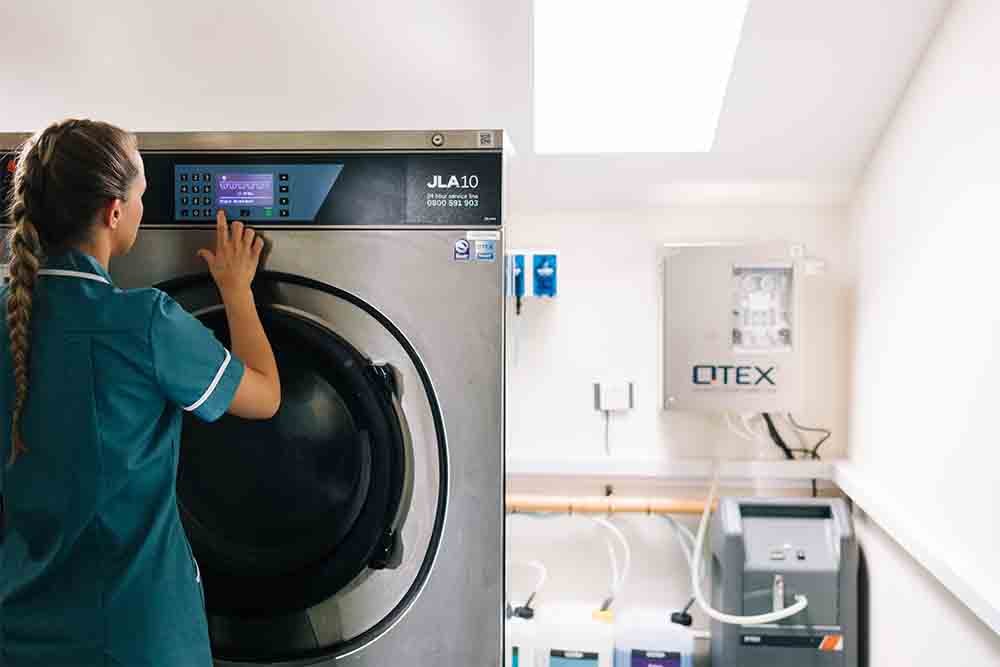From the hospital ward to the residents’ lounge, it’s vital to maintain high standards of infection control in care environments. But with a big focus on energy rates, managers are also looking closer at the energy (and cost) efficiency of the equipment their facilities rely on.
Two products helping to uphold hygiene standards are pulp macerators and bedpan washers. Both offer a lifespan of around 10 years, yet new JLA research shows that differences in energy consumption, water usage, and operating costs do add up. Below, we explore the benefits of using a macerator over a bedpan washer, and how the right choice could enhance care standards, reduce infection risks, and bring you savings.
Macerators reduce infection risks
Studies have shown that bedpan washing carries the risk of transferring infectious bacteria and spores which, when passed to other patients, contribute to billions each year spent on antibiotics, cleaning, testing and nursing costs. As macerators are foot-operated, there’s a significantly reduced risk of infection spread versus bedpan washers, which involve far more hands-on handling (and checking after each cycle). Bedpan washers also rely on temperature checks to guarantee thermal disinfection, while macerators simply process waste with no fuss. This extra layer of protection could mean fewer infections and healthier patients, residents and staff.
Macerators don’t use chemicals or disinfectants
Bedpan washers rely on chemicals and disinfectants to clean reusable products, while a macerator only requires a small amount of water to process pulp containers and waste. This means you’re likely to save money on consumables over the long term, making macerators a cheaper – and potentially greener – choice.
Macerator servicing and maintenance costs are lower
Used properly, your pulp macerator should need less servicing than a bedpan washer throughout its life. As macerators are designed to process waste efficiently, they’re also much less likely to cause drain blockages, reducing the risk of downtime interruptions, and keeping your out-of-plan maintenance costs down.
Macerators save your staff time
Macerators allow carers to quickly and hygienically dispose of pulp and waste, which means their focus can stay on patients and residents. Bedpan washers, meanwhile, often require monitoring, loading and unloading, and careful checking, which can take up precious time and resources.
Macerators use less water and electricity
Costs in focus
By investing in pulp macerator systems, your facilities can improve patient care, drive sustainability, and save on energy costs, all while supporting your infection control strategy.
For help choosing the right systems for your facilities, simply get in touch. Or, for a detailed look at the variance in costs between macerators and bedpan washers, review our table below.
| Cost in use model | Single use system (Macerator & Pulp) | Reusable System (Reusable Utensils & Bedpan Washer Disinfector) | Variance |
|---|---|---|---|
| Capital costs | |||
| Machine cost | £3,000 | £6,000 | £3,000 |
| Life cycle (years) | 10 | 10 | |
| Cost p.a | £300 | £600 | £300 |
| Consumable costs (annual) | |||
| Pulp consumables | £1300 | £0 | -£1,300 |
| Chemicals/disinfectants | £0 | £200 | £200 |
| Servicing costs | £0 | £750 | £750 |
| Labour costs | £0 | £2,080 | £2,080 |
| Number of cycles p.a. | 8,000 | 8,000 | |
| Water | |||
| Consumption (litres) per cycle | 24 | 39 | 15 |
| Cost of water (IN) (per m3) | £1.00 | £1.00 | |
| Cost of water (OUT) (per m3) | £2.00 | £2.00 | |
| Cost of water per cycle | £.0.07 | £0.12 | £0.05 |
| Cost of water p.a | £576.00 | £936.00 | £360 |
| Consumption (litres) p.a. | 192,000 | 312,000 | 120,000 |
| Electricity | |||
| Electricity consumption | 0.0360 | 0.2500 | 0.2140 |
| Cost of electricity (£/Kwh) | £0.10 | £0.10 | |
| Cost of electricity per cycle | £0.004 | £0.03 | £0.02 |
| Cost of electricity p.a. | £28.80 | £200.00 | £171.20 |
| Total cost p.a. per machine | £2,204.80 | £4,766.00 | £2,561.20 |
| Multiple machines for ex. 10 units, total cost per annum | £22,048.00 | £47,660.00 | £25,612.00 |



